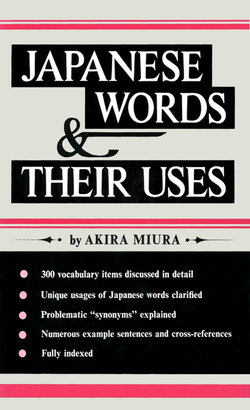Читать книгу Japanese Words & Their Uses II - Akira Miura - Страница 7
На сайте Литреса книга снята с продажи.
ОглавлениеPREFACE
I have been teaching Japanese to Americans for more than seventeen years. During that time I have observed many errors in Japanese made by my American students. Most of these errors are attributable to the students’ insufficient mastery of Japanese grammar (for example, their inability to inflect verbs correctly), but there are also a large number of errors that are basically due to vocabulary problems.
When the American student of Japanese first comes across a new Japanese word, it is usually introduced with the English “equivalent”; e.g., atatakai is matched up with “warm.” The student is therefore very likely to conclude that there is in fact a one-to-one correspondence between the two words, and he does indeed start using atatakai, for example, in all situations where “warm” would be appropriate in English. He might thus say to a Japanese friend in the midst of summer, with the mercury hitting the mid-80s Fahrenheit, Kyoo wa atatakai desu nee meaning “It’s warm today, isn’t it!” That would really baffle the Japanese friend because, in Japanese, temperatures that high are not atatakai but atsui “hot.” Atatakai most aptly describes a nice spring day that arrives after the cold months of winter.
Japanese Words and Their Uses is a reference book that provides help for American students of Japanese, especially those at the elementary and intermediate levels, by explaining approximately three hundred words and phrases. It explains not only how they are used but also how they should not be used, contrasting them as often as possible with their English “equivalents.” Many of the errors cited in this book have actually been committed by my own students (although they are not always quoted verbatim).
There are just as many synonyms in Japanese as there are in English, and they create serious problems for students of Japanese. For example, both omou and kangaeru are usually introduced in textbooks as “to think” without adequate explanation of the difference between them. Therefore, a number of near synonyms such as omou and kangaeru have been included in the book, with sample sentences as well as explanations of their differences.
If American and other English-speaking students of Japanese can find in this book solutions to some of their problems, I will be more than happy. It is also my hope that teachers of Japanese working with English-speaking students may find helpful information in it.
I would like to express my appreciation to Professor Matsuo Soga, of the University of British Columbia, and to Ricky Davis, a graduate student in Japanese at the University of Wisconsin, for reading my manuscript painstakingly and making suggestions to improve it. Thanks are also due to my wife, Charlotte, who proofread the final draft for me.
—Akira Miura
